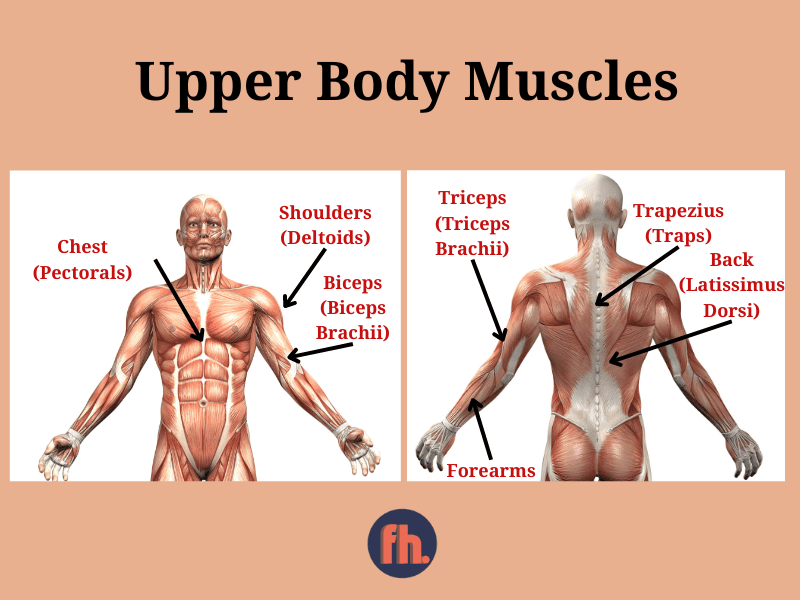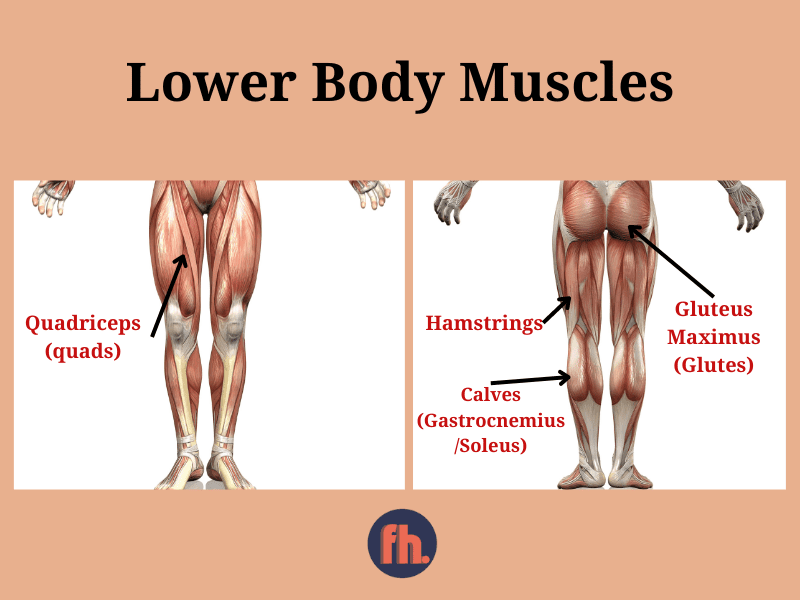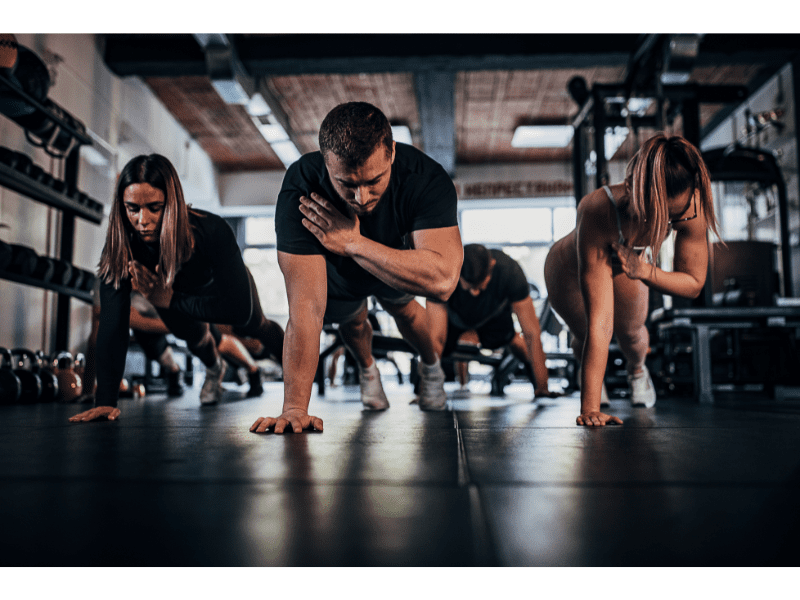What Are Strength Training Exercise?
Strength training exercises are any physical movements that make your muscles work against a form of resistance. This resistance can come from weights, free weights, resistance bands, your own body weight, or even water. Strength training helps you build muscle mass, improve strength, increase bone density, and boost your metabolism.
Note:
It is essential to consult a doctor before starting a strength-training program and to gradually increase intensity based on individual capabilities.
Table of Contents
Definition of muscle group
A muscle group refers to a set of muscles that work together to perform a specific movement or function. Muscles within each group contract in a coordinated manner. Common examples include the quadriceps (front of thighs), hamstrings (back of thighs), deltoids (shoulders), abdominals (core), pectorals (chest), biceps (front of upper arms), triceps (back of upper arms), and erector spinae (lower back). Muscles contains 40 percent of your body weight.
Knowing the different muscle groups is crucial for developing an effective and balanced strength training program, as different exercises target and stress different muscle groups.
Strength training is a crucial component of any well-rounded fitness regimen. By pushing your muscles against resistance, you build strength, increase muscle mass, boost metabolism, and improve overall health markers. However, to truly maximize results from strength training, it’s essential to have a deep understanding of how different muscle groups function and work together as synergistic pairs.
In this comprehensive guide, we’ll explore the key muscle groups, how they enable movement through opposing forces, the benefits of pairing muscles in your workouts, sample exercise programs for all levels, and critical nutrition strategies. Get ready to take your strength training gains to new heights.
The Major Muscle Groups Explained
Before diving into muscle pairings, let’s establish a solid foundation by breaking down the body’s primary muscle groups:
Upper Body Muscles:
Let’s talk about the important muscle groups in your upper body – you know, the ones that really make you look and feel strong!
First up, your chest or pectoral muscles. These bad boys help you push things away from your body, like during bench presses or push-ups. Having a solid chest is key for that powerful pushing motion.
Then we’ve got your back muscles, especially the lats or latissimus dorsi. These are crucial for pulling movements – think rows and pull-ups. A strong back helps you pull your own weight (literally) and provides great stability.
Can’t forget about those shoulder or deltoid muscles either. They’re the real MVPs when it comes to lifting your arms overhead for presses or out to the sides for lateral raises. Broad shoulders? Thank the delts!

Moving down to your biceps and triceps – these are the show muscles of the arms. Biceps help you curl things toward you, while triceps kick in when you need to straighten your elbows back out for moves like dips.
Even your forearms play a role by giving you a strong grip to hang onto weights or equipment. Don’t skip forearm day!
Last but not least, your traps or trapezius muscles at the base of your neck help stabilize your shoulders and keep your posture on point during shrugs or upright rows.
The key is training all these upper body muscle groups together for a balanced, beast-mode physique. Gotta cover all the bases to get swole from head to shoulders!
- Chest (Pectorals) – This powerful group drives pushing movements like bench presses and push-ups.
- Back (Latissimus Dorsi) – The lats are the primary muscles engaged during pulling exercises such as rows and pull-ups.
- Shoulders (Deltoids) – The deltoids elevate the arms and create shoulder power for lifts like overhead presses.
- Biceps (Biceps Brachii) – These muscles flex the elbow joint, as used during bicep curls.
- Triceps (Triceps Brachii) – The triceps extend the elbow joint against the force of the biceps for moves like kickbacks.
- Forearms – The forearm muscles control wrist and hand movements for a powerful grip.
- Trapezius (Traps) – The traps connect the shoulders, neck, and upper back for stability.
Lower Body Muscles:
let’s talk about the powerhouse muscles in your lower body – the ones that keep you grounded and give you that explosive strength!
First up, your quads at the front of those thick thighs. These babies are the real workhorses when it comes to straightening out your knees. You’re gonna need ’em firing on all cylinders for beast mode squats and lunges.
Then we’ve got the hamstrings, chillin’ at the back of your thighs. These guys come into play when you need to bend those knees and drive your hips forward – think big movements like deadlifts and leg curls.

But the real showstopper? Your glutes, especially that massive gluteus maximus! This is the biggest muscle in your entire body and it’s what gives you the power to extend from those hips. Hip thrusts and glute bridges? Thank me later for that peach emoji booty.
Last but not least, the often-neglected calves. Your gastrocnemius and soleus down by the ankles help you get up on your toes for calf raises and propel you forward when running or sprinting.
Training this whole lower body muscle crew isn’t just about looking thick and sculpted, although that’s a nice bonus. It’s also crucial for overall strength, stability and balance whether you’re hitting the gym hard or just going about your day.
So don’t be skipping leg day, bro! Gotta pay your dues working these lower body dynamos if you want that full-body power and athleticism. Holler if you need any other tips for building tree-trunk legs!
- Quadriceps (Quads) – This group of four muscles straightens the knee and powers movements like squats and lunges.
- Hamstrings – Located on the back of the thigh, the hamstrings bend the knee and extend the hips for deadlifts.
- Gluteus Maximus (Glutes) – As the body’s largest muscle, the glutes generate explosive power from the hips.
- Calves (Gastrocnemius/Soleus) – These muscles flex the ankle joint for movements like calf raises.
Core Muscles:
let’s talk about your core – that powerful midsection that acts like the sturdy foundation for your whole body.
First up, your rectus abdominis or the classic “six-pack” abs. These vertical muscle strips running down the front of your belly are the stars of the show when it comes to flexing and crunching that spine. Want a shredded six-pack? Gotta put in the work on moves like crunches and sit-ups.
Then you’ve got the obliques, both internal and external, along the sides of your abdomen. These babies are crucial for twisting and side-bending movements. Wanna feel the burn? Hit some side planks or Russian twists to light up those obliques.

But the real unsung hero? Your transverse abdominis (TVA) – that deep, internal girdle that wraps around your midsection. This muscle acts like a natural weightlifting belt, cinching everything in tight to provide rock solid stability for your spine and pelvis during planks or those vacuum exercises.
Having a strong, solid core isn’t just about looking lean and shredded though. It’s fundamental for functional fitness – everything from basic movements to heavy lifting and athletic performance. A weak core can throw off your whole body’s mechanics and lead to injuries.
So don’t neglect the trunk, bro! Building up these core muscle groups will give you that pillar of strength right through the center, improve your posture and resilience, and help you move more powerfully in the gym and in life. Let me know if you need any core-crushing exercise tips!
- Rectus Abdominis (Abs) – The “six-pack” muscles flex the spine and enable explosive rotational force.
- Obliques (Internal/External) – The obliques enable twisting of the torso for power transfer.
- Transverse Abdominis (TVA) – This deep core muscle stabilizes the spine and facilitates force production.
Understanding Opposing Muscle Groups
While isolated exercises like bicep curls work individual muscles, the human body is designed for the muscles to work in opposing, synchronized pairings called “antagonistic muscle groups.” Key opposing muscle groups include:
Biceps vs. Triceps
The biceps and triceps function as opposing forces across the elbow joint. Biceps bend the elbow, while triceps straighten it. Training both in the same session ensures joint stability and balanced development.
Sample Exercises:
- Bicep Curl (biceps)
- Tricep Dip (triceps)
- Hammer Curl (biceps)
- Skull Crusher (triceps)
Chest vs. Back
The pectorals (chest) and the latissimus dorsi (back) work in opposition for pushing and pulling motions. Together, they drive powerful movements like bench presses, rows, and swimming strokes.
Sample Exercises:
- Bench Press (chest push)
- Bent-Over Row (back pull)
- Push-Up (chest push)
- Seated Cable Row (back pull)
Quadriceps vs. Hamstrings
The quadriceps straighten the knee through extension, while the hamstrings flex the knee and power hip extension. Pairing quad-dominant and hamstring-dominant exercises promotes balanced leg development.
Sample Exercises:
- Barbell Back Squat (quads)
- Romanian Deadlift (hamstrings)
- Walking Lunge (quads and hamstrings)
- Glute Bridge (hamstrings and glutes)
Proper training of opposing muscle groups leads to improved symmetry, injury prevention, and maximal strength expression across all planes of movement.
The Benefits of Muscle Group Pairing
Incorporating strategic muscle pairing into your strength program yields numerous rewards:
- Increased Training Efficiency- By alternating between agonist and antagonist muscle groups, you can train opposing muscle pairs in the same session. This allows one group to recover while the other is working, enabling harder, more productive workouts.
- Accelerated Recovery- Switching between push and pull movements prevents excessive fatigue and overuse injuries from single-group specialization. The alternating stress and recovery facilitates faster bounce-back between sessions.
- Boosted Metabolism– Pairing lower and upper body exercises amplifies the overall physical demand and calorie expenditure during the workout. This metabolic boost persists for hours post-workout, increasing fat loss potential.
- Time Efficiency– For busy individuals, strategically combining muscle groups into full-body routines maximizes workout density and allows you to hit every muscle group in minimal time.
- Improved Muscular Balance– Negligence of opposing muscle groups leads to imbalances, postural issues, and increased injury risk. Muscle pairings promote balanced development of agonists and antagonists.
Sample Muscle Group Pairing Workout Splits
The American Heart Association says that strength and resistance training exercise is one of the four types of exercise along with endurance, balance and flexibility. Give your body time to recover, Trusted Source advises separating lilting sessions by at least two days.
With an understanding of muscle pairings, we can construct efficient workout splits for all levels:
Beginner Full-Body Workout (2-Day Split)
Day 1: Lower Body & Core
- Squats: 3 sets of 12-15 reps
- Deadlifts: 3 sets of 8-10 reps
- Walking Lunges: 2 sets of 10 reps per leg
- Planks: 3 sets of 45-60 second holds
- Crunches: 2 sets of 15-20 reps
Day 2: Upper Body
- Bench Press: 3 sets of 10-12 reps
- Seated Cable Rows: 3 sets of 10-12 reps
- Bicep Curls: 2 sets of 12-15 reps
- Tricep Extensions: 2 sets of 12-15 reps
- Overhead Presses: 3 sets of 10-12 reps
Beginner Full-Body (2-Day Split)
- Rest 60-90 seconds between sets
- Use a weight that allows you to complete reps with proper form
- Focus on learning and mastering movement patterns
- Can substitute other core exercises for crunches if preferred
- Perform 2-3 total body workouts per week, resting at least 1 day in between
Intermediate Upper/Lower Split (3-Days)
Day 1: Upper Body Push (Chest, Shoulders, Triceps)
- Bench Press: 4 sets of 8-10 reps
- Incline Dumbbell Press: 3 sets of 10-12 reps
- Seated Dumbbell Shoulder Press: 3 sets of 10-12 reps
- Dips: 3 sets to failure
- Tricep Pushdowns: 3 sets of 12-15 reps
Day 2: Upper Body Pull (Back, Biceps)
- Pull-Ups: 4 sets to failure
- Single-Arm Dumbbell Rows: 3 sets of 8-10 reps per arm
- EZ-Bar Bicep Curls: 4 sets of 8-10 reps
- Face Pulls: 3 sets of 12-15 reps
- Dumbbell Hammer Curls: 3 sets of 10-12 reps
Day 3: Legs
- Barbell Back Squats: 5 sets of 6-8 reps
- Romanian Deadlifts: 4 sets of 8-10 reps
- Leg Press: 3 sets of 12-15 reps
- Seated Calf Raises: 4 sets of 12-15 reps
- Hanging Leg Raises: 3 sets of 12-15 reps
Intermediate Upper/Lower (3-Day Split)
- Rest 60-90 seconds between sets for upper body workouts
- Rest 90-120 seconds between sets for leg workouts
- Use a weight that allows you to complete reps in the target range with good form
- Gradually increase weight over time to continue progressive overload
- Can substitute pull-up alternatives like lat pulldowns if unable to do full pull-ups
- Perform the 3 workouts one after the other, resting at least 1 day between each
Note:
- Warm up properly before each workout with light cardio and dynamic stretches
- Focus on contracting the target muscles and controlling reps
- Listen to your body and adjust volume/intensity as needed
- Cool down with static stretches for major muscle groups worked
- Allow for overall recovery by taking 1-2 complete rest days per week
Advanced Push/Pull/Legs Split (4-Days)
Day 1: Push (Chest, Shoulders, Triceps)
- Barbell Bench Press: 4 sets of 6-8 reps
- Seated Dumbbell Shoulder Press: 3 sets of 8-10 reps
- Incline Dumbbell Bench Press: 3 sets of 10-12 reps
- Tricep Dips: 3 sets to failure
- Lateral Raises: 3 sets of 12-15 reps
- Skull Crushers: 2 sets of 10-12 reps
Day 2: Pull (Back, Biceps)
- Deadlifts: 5 sets of 5 reps
- Pull-Ups: 4 sets to failure
- Seated Cable Rows: 4 sets of 8-10 reps
- Barbell Bicep Curls: 3 sets of 8-10 reps
- Face Pulls: 3 sets of 12-15 reps
- Hammer Curls: 2 sets of 10-12 reps
Day 3: Legs (Quads, Hamstrings, Glutes, Calves)
- Back Squats: 5 sets of 6-8 reps
- Romanian Deadlifts: 4 sets of 8-10 reps
- Leg Press: 3 sets of 12-15 reps
- Seated Leg Curls: 3 sets of 10-12 reps
- Walking Lunges: 3 sets of 10 reps per leg
- Seated Calf Raises: 4 sets of 12-15 reps
Day 4: Pull (Back, Biceps) & Core
- Bent-Over Barbell Rows: 4 sets of 6-8 reps
- Lat Pulldowns: 3 sets of 10-12 reps
- Straight-Arm Pulldowns: 3 sets of 12-15 reps
- EZ-Bar Preacher Curls: 3 sets of 8-10 reps
- Hanging Leg Raises: 3 sets of 12-15 reps
- Planks: 3 sets of 60 second holds
This advanced 4-day push/pull/legs split allows for specialization on the major muscle groups while enabling recovery between sessions. It utilizes heavy compound movements paired with targeted accessory lifts for complete muscular development. Adjust volumes and intensities as needed based on your experience level.
Note:
- Adjust weight, reps, and sets based on your strength levels
- Focus on compound lifts like presses, rows, squats, and deadlifts
- Allow for at least one day of rest between workouts
- Incorporate drop sets, forced reps, and other intensity techniques periodically
- Start with a de-load/light week every 4-6 weeks to avoid overreaching
Progressing With Muscle Pairing
To continue making gains, you must apply progressive overload by gradually increasing the workout intensity over time through:
- Higher Training Volumes (more reps, sets, or exercises)
- Heavier Loading (adding weight to lifts in a controlled manner)
- Increased Training Density (less rest between sets)
- Adding Advanced Training Techniques (drop sets, forced reps, etc.)
Be sure to listen to your body, deload when needed, and make use of active recovery days to prevent overreaching.
Workout Finishers for Advanced Muscle Conditioning
For an extreme metabolic finisher after your main muscle pairing workout, try combining exercises from opposing muscle groups:
- Burpee to Overhead Press
- Thrusters (Front Squat to Push Press)
- Sled Pushes & Drags
- Bear Crawls & Mountain Climbers
- Med Ball Slams & Sit-Up Throws
The Nutrition Factors for Maximum Muscle
What you eat is just as crucial as how you train for fueling muscle growth and recovery:
Protein Intake Aim for 0.7-1.0 grams of protein per pound of body weight from high-quality sources like:
- Lean meats (chicken, turkey, lean beef)
- Fish and seafood
- Eggs and dairy
- Protein supplements (whey, casein, plant-based)
Meal Timing Optimize your nutrition around your muscle pairing workouts:
- Consume a meal with protein and carbs 1-2 hours pre-workout
- Have a protein shake with simple carbs immediately post-workout
- Eat a balanced meal with protein and complex carbs 1-2 hours after training
Macro Ratios Your macro ratios (protein/carb/fat breakdown) should align with your goals:
- Bulking/Muscle Gain: Higher calorie surplus with 30% protein, 40% carbs, 30% fats
- Cutting/Fat Loss: Moderate calorie deficit with 40% protein, 30% carbs, 30% fats
Supplements Certain supplements can provide a research-backed boost:
- Creatine Monohydrate – Increases power output and lean mass
- Caffeine – Enhances energy, focus and athletic performance
- BCAAs – Prevent muscle protein breakdown and support recovery
- Fish Oil – Reduces exercise-induced inflammation
Benefits for Specific Populations
The principles of muscle pairing can be adapted for various populations to achieve specialized goals:
- For Seniors – Maintains functional strength, prevents sarcopenia (age-related muscle loss) and reduces fall/injury risk.
- For Athletes – Enhances power production, joint stabilization, and full-body conditioning for elite performance.
- For Women – Builds shapely curves through targeted muscle development while boosting metabolism.
- For Injury Rehabilitation – Restored joint strength and stability following an injury through balanced muscle pairings.
Common Questions on Muscle Groups
What are antagonistic muscle groups?
Antagonistic muscle groups are pairs of muscles that work in opposition to each other to create movement at a joint. A classic example is the biceps and triceps across the elbow joint. The biceps flexes the elbow to bend it, while the triceps extends the elbow to straighten it.
How can I identify what muscle group an exercise works?
The easiest way is to observe what motions and joint actions the exercise involves. For example, a pushing motion that extends the elbow likely works the triceps muscle group. Pulling motions and elbow flexion emphasizes the biceps muscle group.
What are compound exercises?
Compound exercises are multi-joint movements that work multiple major muscle groups across the body in a synergistic manner. Examples include:
- Squats (quadriceps, hamstrings, glutes, core)
- Deadlifts (hamstrings, glutes, back, trapezius)
- Pull-ups (back, biceps, forearms)
- Pushups (chest, shoulders, triceps, core)
- Lunges (quadriceps, hamstrings, glutes)
- Shoulder Presses (shoulders, triceps, core)
- Bent-Over Rows (back, biceps)
Compound exercises allow you to recruit more total muscle mass and burn more calories compared to isolation exercises. They are extremely efficient for total-body muscle building.
I hope this guides provides you with a clear understanding of muscle groups, how they are defined, how to identify them through exercises, and the importance of working multiple muscle groups through compound training. Let me know if any other questions arise
By strategically combining exercises that pair agonist and antagonist muscle groups, you’ll be primed to maximize strength and hypertrophy gains while improving joint integrity and functional capacity. The keys to successful muscle pairing:
- Master proper exercise form through coaching and video guides
- Follow a workout split tailored to your experience level and schedule
- Progress with periodized overload and recovery protocols
- Dial in your nutrition and supplement regimen for muscle building
- Train consistently, safely, and with intensity for best results!
This science-backed approach is proven to yield incredible total-body transformations. What are you waiting for? Apply the principles of muscle pairing to your training and get ready to take your strength to breathtaking new heights.
Sources:
- Physiology, Muscle- StatPearls-NCBI Bookshelf. https://www.ncbi.nlm.nih.gov/books/NBK532258/
- Upper limb muscles and movements. By kenhub.com. https://www.kenhub.com/en/library/anatomy/upper-limb-muscles-and-movements
- Lower limb anatomy. By kenhub.com. https://www.kenhub.com/en/library/anatomy/lower-extremity-anatomy
- Core Muscles. By physio-pedia.com. https://www.physio-pedia.com/Core_Muscles
- Strength and Resistance Training Exercise. By heart.org. https://www.heart.org/en/healthy-living/fitness/fitness-basics/strength-and-resistance-training-exercise
- How Much Protein You Should Eat to Build Muscle. By eatingwell.com. https://www.eatingwell.com/article/8022938/how-much-protein-to-build-muscle/
- Workout Supplements| The Nutrition Source| Harvard T.H Chan School. By hsph.harvard.edu. https://www.hsph.harvard.edu/nutritionsource/workout-supplements/


2 thoughts on “Understanding Muscle Groups for Maximizing Strength Training Results”